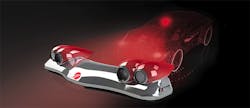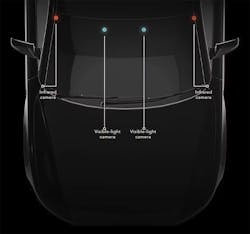Detection of obstacles and traffic signs can be done using video cameras and vision-processing software. This offers the advantage of being a passive system versus LiDAR or radar. The challenges, though, are the video processing that must be done and the difficulty in analyzing images to determine distance as well as shapes and sizes of obstacles. This can be difficult with one camera, but two cameras in a stereo configuration make the latter easier.
1. Foresight’s QuadSight has a 150-m detection range and delivers information at 45 frames/s.
Foresight’s QuadSight vision system (Fig. 1) uses four cameras to deliver close to 100% accurate obstacle detection for automotive applications. Check out this video:
Two of the cameras are high-definition RGB devices, while the other two are infrared cameras. This expands the detection range from just visible light through infrared. Infrared detection is useful in general, but it also improves nighttime detection as well as operation in rain, haze, and fog. It allows the system to be operational in all kinds of weather, allowing for 24/7 operation.
The cameras are paired to generate a stereoscopic view that makes image analysis easier and more accurate when it comes to determining an object’s size and distance from the cameras. Cameras are mounted on either side of the car looking forward (Fig. 2). This provides 45-deg. coverage.
2. QuadSight, with its two visible-light and two infrared cameras, offers a stereoscopic view to provide higher-accuracy analysis.
The system has a 150-m detection range, and its sensor exceeds the detail that’s detectable by a human—it can detect objects as small as 35 by 25 cm at 100 m. The ability to identify such extra-small objects at long range and delivering 45 frames/s allows for vehicle operation at high speeds.
Foresight’s proprietary technology combines sensor fusion with advanced 3D image analysis algorithms. It provides automatic calibration and detects almost 100% of all obstacles with nearly zero false alerts.




